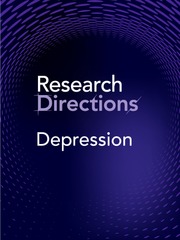In recent years, there has been considerable enthusiasm among research groups focused on developing novel therapies for treatment-resistant depression, and a wider community that has had experiences using recreational drugs, in more systematic evaluation of the therapeutic value of these compounds (Goodwin et al., Reference Goodwin, Aaronson, Alvarez, Arden, Baker, Bennett, Bird, Blom, Brennan, Brusch, Burke, Campbell-Coker, Carhart-Harris, Cattell, Daniel, DeBattista, Dunlop, Eisen, Feifel, Forbes, Haumann, Hellerstein, Hoppe, Husain, Jelen, Kamphuis, Kawasaki, Kelly, Key, Kishon, Knatz Peck, Knight, Koolen, Lean, Licht, Maples-Keller, Mars, Marwood, McElhiney, Miller, Mirow, Mistry, Mletzko-Crowe, Modlin, Nielsen, Nielson, Offerhaus, O’Keane, Páleníček, Printz, Rademaker, van Reemst, Reinholdt, Repantis, Rucker, Rudow, Ruffell, Rush, Schoevers, Seynaeve, Shao, Soares, Somers, Stansfield, Sterling, Strockis, Tsai, Visser, Wahba, Williams, Young, Ywema, Zisook and Malievskaia2022; Young, Reference Young2023). This has also been associated with advocacy for decriminalization, legalization and possible public licensing for their ‘medicinal’ use (Siegel et al., Reference Siegel, Daily, Perry and Nicol2023).
While previously the barriers to ongoing development of these therapeutic approaches have included major legal hurdles (stemming from their criminalization), new concerns are not limited to the potential for abuse. The capacity of these compounds to induce significant shorter- and longer-term adverse effects (including psychotic-like states and suicidality) has long been recognized and has in part underpinned termination of their pharmaceutical development by industry. The lack of clear information about relevant doses and reliable sources of these compounds needs to be addressed urgently. The clear need to assess longer-term efficacy and potential side effects is recognized by both research groups and regulatory bodies.
The notion that the therapeutic efficacy of these agents is also dependent on concurrent psychological therapies has focused attention on the need to define and evaluate the therapeutic components of the non-pharmacological elements that should accompany these interventions. The need to provide safe environments, and additional skilled staff, for their widespread therapeutic use presents real challenges for many health systems.
Despite these concerns, the reality is that such psychedelic and stimulant agents have been widely used outside traditional medical systems, are promoted broadly as having dramatic therapeutic benefits (often described as being curative after only one exposure) and attract people into care who have otherwise been disappointed by experiences with conventional interventions. They also have the potential to bring into mental health care those who otherwise actively avoid conventional medicines.
These developments of ‘recreational’ agents sit alongside more traditional pharmacological approaches to the development of related compounds, including modulation of the endogenous cannabinoid (endocannabinoid) system (ECS). Here, synthetic and more specific compounds that target defined parts of the ECS (potentially blocking the metabolism of the two main endocannabinoids – anandamide and 2-arachidonoylglycerol (2-AG)) are under development. However, these novel compounds will face traditionally high regulatory and clinical trial hurdles before they are available for widespread clinical use.
So, there are real concerns as to how quickly and appropriately sufficient clinical trial evidence (particularly on dose, optimal modes of administration and shorter- and longer-term efficacy), and concurrent investigation of mediating mechanisms, can be accumulated to inform this rapidly developing field. There are also major social policy issues at stake – to what extent should conventional regulatory practices be put aside in favour of patients’ requests for choice and legal access to these alternatives, and the recognition that use of these compounds is already widespread outside of regulated practice settings?
How to contribute to this question
If you believe you can contribute to answering this Question with your research outputs find out how to submit in the Instructions for authors (https://www.cambridge.org/core/journals/research-directions-depression/information/author-instructions/preparing-your-materials). This journal publishes Results, Analyses, Impact papers and additional content such as preprints and ‘grey literature’. Questions will be closed when the editors agree that enough has been published to answer the Question so before submitting, check if this is still an active Question. If it is closed, another relevant Question may be currently open, so do review all the open Questions in your field. For any further queries check the information pages (https://www.cambridge.org/core/journals/research-directions-depression/information) or contact this email (depression@cambridge.org).
Competing interests
IBH is the Co-Director of Health and Policy at the Brain and Mind Centre (BMC) University of Sydney. The BMC operates an early-intervention youth services at Camperdown under contract to headspace. He is the Chief Scientific Advisor to, and a 3.2% equity shareholder in, InnoWell Pty Ltd which aims to transform mental health services through the use of innovative technologies. FML is a shareholder of curantis UG (Ltd.). He received a research grant from Endosane Pharmaceuticals GmbH.





